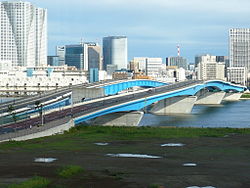Koto, Tokyo
|
Koto 江東区 |
|||
|---|---|---|---|
| Special ward | |||
| Kōtō City | |||

Great Harumi Bridge in Kōtō
|
|||
|
|||
 Location of Koto in Tokyo |
|||
| Location in Japan | |||
| Coordinates: 35°40′N 139°49′E / 35.667°N 139.817°ECoordinates: 35°40′N 139°49′E / 35.667°N 139.817°E | |||
| Country | Japan | ||
| Region | Kantō | ||
| Prefecture | Tokyo | ||
| Government | |||
| • Mayor | Takaaki Yamazaki | ||
| Area | |||
| • Total | 40.16 km2 (15.51 sq mi) | ||
| Population (May 1, 2015) | |||
| • Total | 488,632 | ||
| • Density | 12,170/km2 (31,500/sq mi) | ||
| Time zone | Japan Standard Time (UTC+9) | ||
| City hall address | 東陽4-11-28 135-8383 |
||
| Website | www |
||
Koto (江東区 Kōtō-ku?, "East of River") is a special ward located in Tokyo Metropolis, Japan. The ward refers to itself as Kōtō City in English.
As of May 1, 2015, the ward has an estimated population of 488,632 and a population density of 12,170 persons per km². The total area is 40.16 km².
Kōtō is located east of the Tokyo metropolitan center, bounded by the Sumida-gawa to the west and the Arakawa River to the east. Its major districts include Kameido, Kiba, Kiyosumi, Monzen-nakachō, Shirakawa, and Toyosu. The waterfront area of Ariake is in Kōtō, as is part of Odaiba.
"Koto" means "East of River" in Japanese.
Kōtō occupies a position on the waterfront of Tokyo Bay sandwiched between the wards of Chūō and Edogawa. Its inland boundary is with Sumida. Much of the land is reclaimed, so there are few old temples or shrines.
Noteworthy places in Kōtō include:
The western part of the ward was formerly part of Fukagawa Ward of Tokyo City. It suffered severe damage in the 1923 Great Kantō earthquake, and was heavily bombed during World War II.
The special ward was founded on March 15, 1947 by the merger of the wards of Fukagawa and Jōtō.
...
Wikipedia



